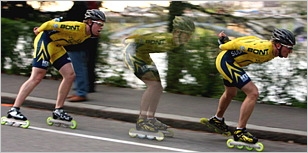 | |||||||||||||||||||
 | |||||||||||||||||||
| |||||||||||||||||||
| |||||||||||||||||||
Skate skills: This week's tip:
Imagine yourself in all the many positions you may find yourself in a race. By Alexander Bont Imagery is an extremely effective tool for winning races. Though at first blush it may seem foreign or esoteric, all it involves is creating a mental experience that you can use later to your advantage. The first step is to start thinking about your competitors. From previous experience or watching videos, learn their strengths and weaknesses. Figure out when they are likely to attack, how far they can sprint at the finish, and whether they are good climbing or descending hills. Then think about every possible position you may find yourself in during a race. Picture yourself behind them ... in front of them ... in-between another team ... in the perfect position for the finish ... etc. Now picture yourself passing them on the inside and the outside with 100 meters to go ... 200 meters to go ... etc. On race day, when you actually find yourself in these situations, it will be déjà vu all over again. You will feel like you have already been there, and you will be ready to make spit-second decisions. These split-second decisions often make or break a race. If you see a gap and you hesitate, it can mean the difference between kissing girls on the podium and sucking oranges on the curb. Here is an example of how to do your pre-race imagery: Let's say that tomorrow you have a 1000-meter race. You know that there are three other guys in the race: James, Jihad, and Jin-Mi. Here's what you know about the four of you:.
Therefore, you can be pretty sure that with James' endurance capabilities, he will be trying to burn the two sprinters away. Jihad, being a sprinter, will not want to be leading so you can expect him to try to stay in second position so he can blow by James near the finish. But second place is also where you would like to be so you will probably visualize yourself in second or third position behind James. Visualize yourself in as many of these positions as possible and visualize yourself overtaking the competition in as many ways as possible. If Jin-Mi finds his way to the front, it could disrupt your attack, so plan accordingly. Obviously anything can happen in a race, but the more scenarios you visualize the better your chances of reacting appropriately when things happen. You may be surprised how predictable races can be when you know the competition. Sprinters usually start their sprint at the same distance out from the finish line every time. Long distance skaters usually go to the lead early in the race and try to blow off the sprinters. Imagery is also an effective tool for planning attacks during a marathon. As part of your pre-race imagery, picture yourself in the pack and imagine where you and your team should be positioned before launching an attack. When should you do this imagery thing? ... The best time is before going to sleep on the night before your race. (Give it an hour or two.) Then the visualizations will be fresh in your mind on race day. (Besides, you usually won’t have time for it on the day of the race.) Just go to bed earlier than normal and keep visualizing different scenarios until you drift off to sleep. Try it. I am sure it will help you position yourself better in races, and it will definitely make those split second decisions feel like second nature. --- Alexander Bont, son of the world-renowned • Bont Skates web site.
| |||||||||||||||||||

 boot maker Inze Bont, started skating when he was two and went on to become a champion speed skater on both ice and inline skates. During his racing career, he spent seven years on the Australian national short track team and was a New South Wales inline champion. Since retiring from racing, he has coached extensively and travels worldwide as the marketing manager of Bont Skates.
boot maker Inze Bont, started skating when he was two and went on to become a champion speed skater on both ice and inline skates. During his racing career, he spent seven years on the Australian national short track team and was a New South Wales inline champion. Since retiring from racing, he has coached extensively and travels worldwide as the marketing manager of Bont Skates.
